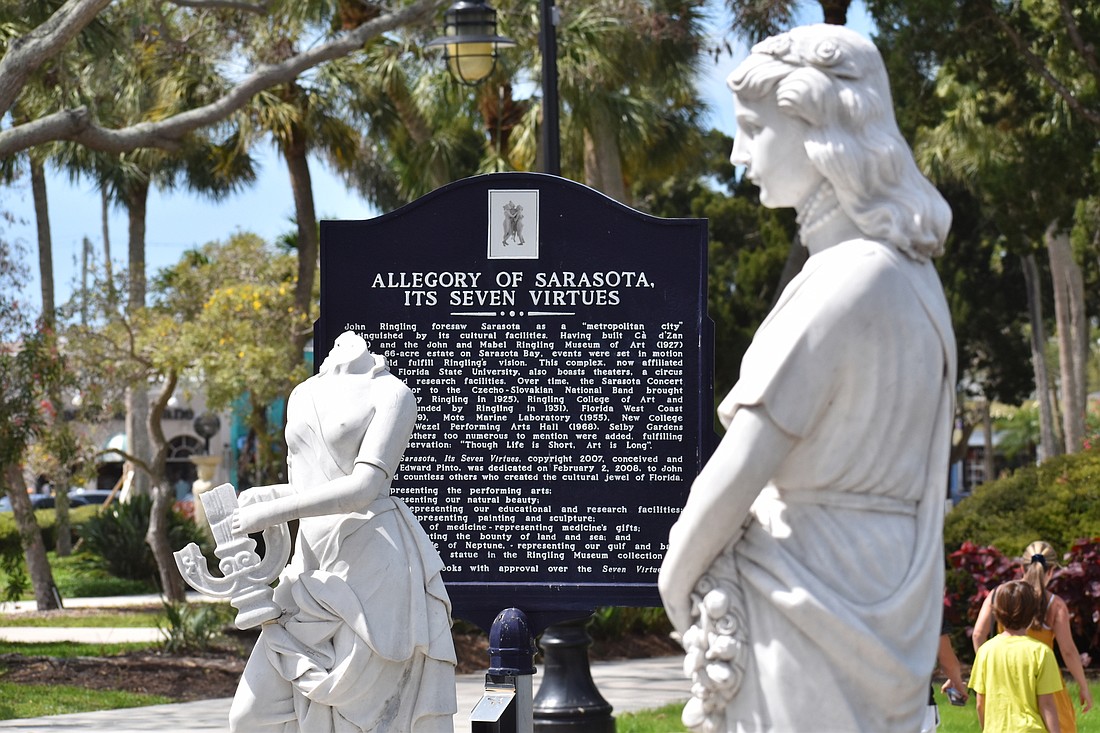- November 23, 2024
-
-
Loading

Loading

Seven virtues.
Six heads.
One confounding set of circumstances for members of the St. Armands Business Improvement District and Sarasota city leaders over “Music,” one of a collection of statues arrayed near a crosswalk at the eastern approach to the shopping district, and her statuary siblings.
It’s been months since damage was done to “Music,” which stands near an informational sign explaining the “Allegory of Sarasota” through seven qualities of life: water, music, flora, sculpture, learning, medicine and bounty.
In addition to her noggin, fingers are missing from her left hand, as are her right forearm, the majority of a stringed musical instrument and the hand that once held it.
“The Seven Virtues” was dedicated in 2008, joining some new works and some donated by John and Mable Ringling throughout the Circle and St Armands Key, totaling 33.
Mary Davis Wallace, a senior planner with the city and leader of the Office of Public Art, and Todd Kucharski, general manager of the city’s Public Works Department, spoke recently to the BID’s board of directors to gain insight into how to proceed not only with repair to “Music” but also on a broader view of all of the Circle’s works.
“They are beloved,” Wallace said.
Kucharski said the city has received a bid of about $12,000 to clean and repair 15 statues in need of attention, including “Music,” but no money exists in the city Public Works Department budget for such work.
“This type of vandalism that occurred is substantial,” he said, adding that the statue was found on the ground and was reset to prevent further damage. “Public Works looked at it as it’s within our right of way, but it’s not green and growing like in Parks and Recreation, so we took it on as the potential to see what we could do. Public Works did not fund or have any funds available for the repair work.”
Wallace said five years of money for upkeep of the 2008 donations was set aside but not renewed. And although the artwork is for all to see, it doesn’t fall under the purview of the Office of Public Art, which is funded through a fee paid by developers when they apply for a city building permit valued at $1 million or more.
She said “Music” and statues like it are “very close to people’s hearts” but are made of lower-quality pressed marble dust, not a traditional original sculpture.
Wallace, who is coordinating an overarching public art master plan for the city, said that it ultimately might be a good idea to create a segment of the proposal to deal with “cultural amenities” that sit outside the boundaries of traditional art but still need funding for upkeep and repairs. While that plan will likely be delivered to city leaders in early 2023, Wallace suggested BID and the city work together on devising a plan for St. Armands statue upkeep and repair until then.
“Cultural amenities to me are beloved items that aren’t necessarily original art but that the community really feels special about them,” she said.
Gavin Meshad, chair of the BID, said a renewed vision for the Circle should include the statues but that residents and shop owners should have a say in how they are displayed and kept up.
Meshad suggests hearing from the residents and others about what they want to see happen.
“If the residents and the merchant say, ‘Oh my gosh, this is the history of the Circle. We love them. This is such a great gift to the Circle,’ we could find a place in the redesign of the Circle,” he said.
Among the ideas: raising the statues higher to keep damaging hands off or using landscaping to prevent close access.
“If you think of old statuary, sometimes heads are missing, arms are missing, so at least as far as I’mseeing, there is no further damage being done,” Kucharski said.